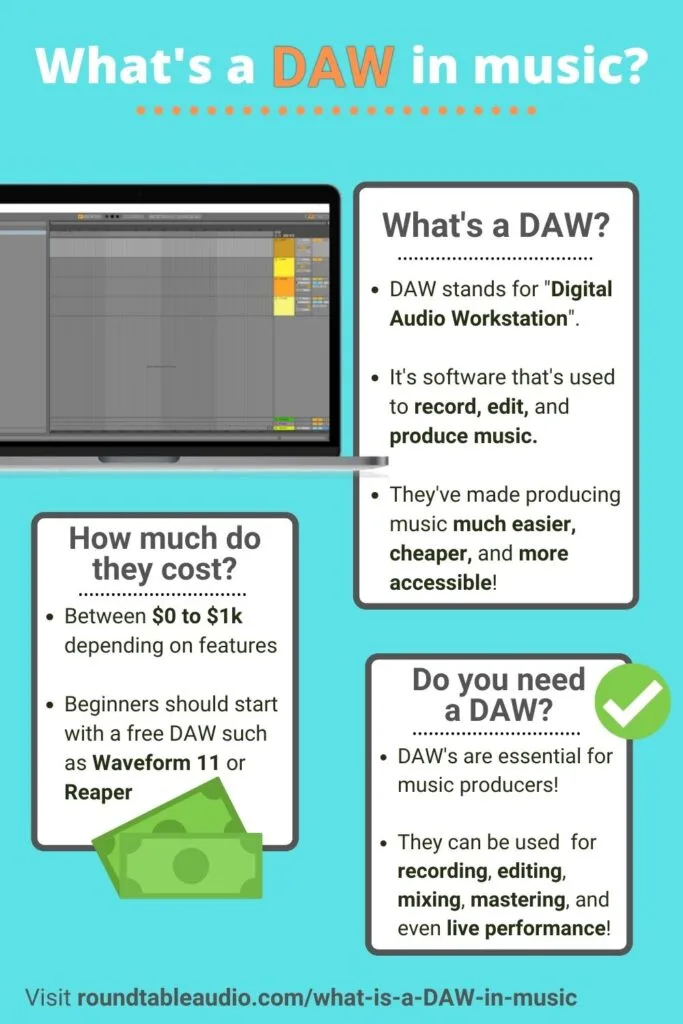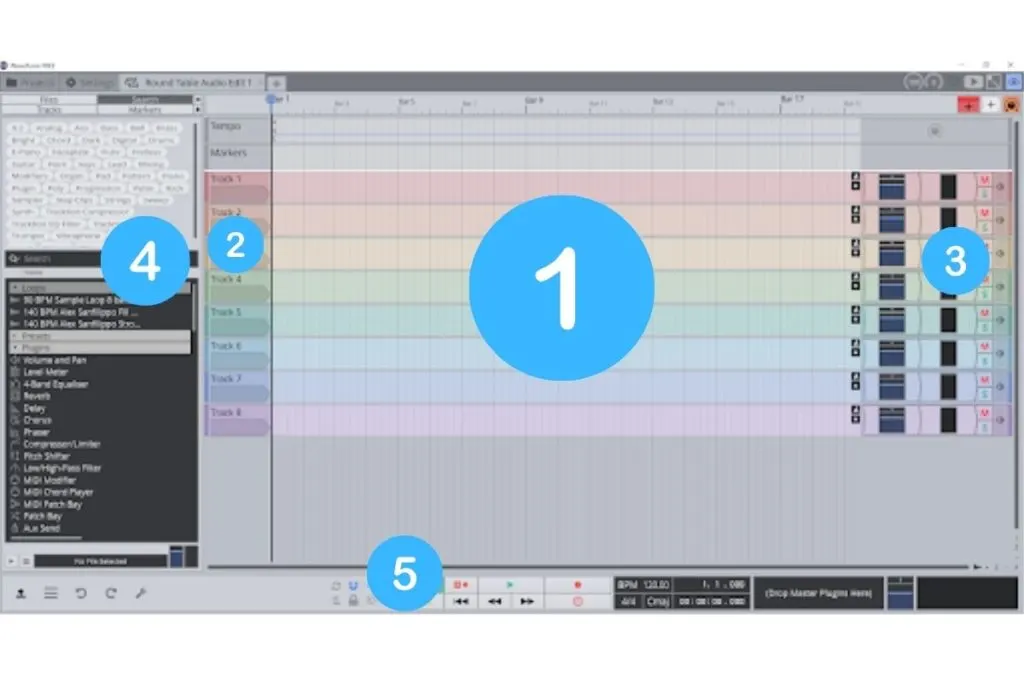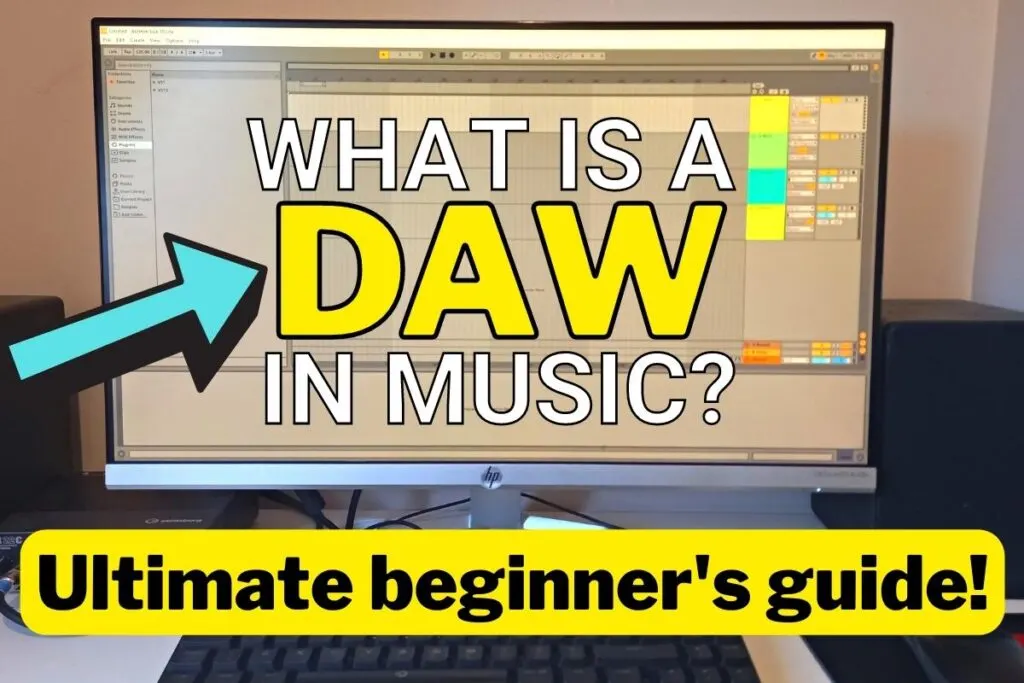If you’re a beginner music producer, you’ve probably heard people using the term “DAW” when talking about music production and now you’re looking to learn more about what a DAW, and what they do.
In music production, a DAW (which stands for Digital Audio Workstation) is the software used to record, edit, and process audio. Examples of DAWs include Ableton Live, Pro Tools, Logic, and Garageband.
DAWs are essential pieces of software for music producers. As such, they require an in-depth understanding in order to get the most benefit from them and make the best music possible.
I’ve made this guide to help you understand everything you need to know to about DAWs.

What is a DAW in music?
A Digital Audio Workstation (DAW) is a piece of software that’s used by music producers to record and produce audio on a computer or laptop. In fact, the introduction of DAWs in the early 1980’s revolutionized how music was recorded.
Historically, music producers had to record instruments using expensive hardware and reel-to-reel magnetic tape, which could be a time consuming and expensive process.
The invention of DAWs meant that producers could now record audio digitally to a computer. They could also replace expensive hardware such as compressors and equalizers with software replicas within the DAW called Virtual Studio Technology (VST’s). VSTs are also called “plugins”.
This made the process of recording much cheaper, and much more accessible to producers. So much so that now many beginner producers are able to use DAWs for free to start making music from their homes.
Over time, DAWs have become an essential part of any music producer’s process. In the modern day, it’s hard to make music without them.

How much do they cost?
DAWs range greatly in cost depending on the features that they contain. If you’re just looking for a simple programme to record audio, you can use a free programme such as Waveform 11 (which is my recommended pick for a beginners DAW). For a top-of-the-line DAW that comes with a full range of high quality VSTs, such as Ableton Live Suite, you’ll be looking at $749 or £539.
There’s a wide range of DAW options available. I recommend installing a free DAW and learning how to produce music on it. As you learn, you will begin to get a better idea of what you need from a DAW, and can spend your money wisely on the DAW that’s right for you.
How do they work?
DAWs are software that’s installed onto your computer or laptop, and operates exactly like any other programme or application. Once you open it up, you’ll be met with a view that’s similar to the below.

Here’s a summary of the basic sections that are featured in all DAWs, and what they’re used for.
- Arrangement: This is the main part of any DAW. It’s the area that you will see your recorded audio and MIDI appear.
- Tracks: Tracks are the sections that you record your audio into. If you’re just recording a podcast, you might only use one track to record your voice. If you’re recording a song, you’ll likely have a track for each instrument. All tracks are “stacked” on top of each other, so play at the same time.
- Mixer: The mixer is used to change the volume of each track. This means that you can turn certain instruments up or down, depending on how you want them to sound.
- VST bank: The VST bank contains all the available VST’s in your DAW. Most free DAWs will come with at least a few basic VSTs, whereas more expensive DAWs will come with a range of higher quality VSTs. You don’t have to rely on the VSTs that your DAW comes with, you can download and install additional ones at any time. Most VSTs are used by dragging and dropping them onto a track. This might be a compressor to make a drum more punchy. It could also be a virtual instrument, like a piano, that’s controlled by using MIDI.
- Playback controls: These are the controls you use to rewind, pause, play, and record for your DAW.
This should give you a bit of a better idea what to expect from a DAW, but it’s in no way all they offer. In fact, most DAWs offer really in-depth options to help you make the best music possible. I’d recommend that you download a free DAW to learn about the different sections in-depth.
Are they easy to use?
I’ve found that most DAWs are straightforward to learn and use. While they all have slightly different features and functions, they mostly work in the same way. I think a beginner could be able to record music after just an hour of reading the software manual.
To better understand your DAW, and the more advanced functionality, I’d recommend setting aside a couple of hours a day to read through the software manual and practice using the different functions. After a week, you will be much more familiar and competent with your DAW.
What can they do?
Modern DAWs are really powerful pieces of software and have a wide range of uses for music production. These include:
Recording and editing audio
By connecting your instrument or microphone to your computer using an audio interface, you can record the audio signal into your DAW. If you’re not happy with your first take, you can delete it, re-record, or edit it with ease.
Processing audio
You can process your audio in a DAW in many different ways, mostly involving VSTs. These can emulate effects such as compression or reverb, or even guitar amplifier simulation. This means that you can have a whole music studio within your computer or laptop! In fact, some music producers can make and perform music just using their laptops.
Recording and editing MIDI
MIDI stands for “Musical Instrument Digital Interface”, and is essentially an instruction from a device that tells your computer what to do.
For example, pressing a piano key on a traditional piano will make a hammer strike a string, which will make a musical note. Pressing a key on a MIDI keyboard, however, sends instructions to your computer to perform a certain function. If you’re using a piano VST, the instruction will likely be to play a note.
This means that you can use many virtual instruments using only one controller, most commonly a MIDI keyboard.
Not only this, but you don’t even have to play the MIDI keyboard if you don’t want to. MIDI instructions can also be input or “drawn” using your computer mouse, which means that you can create complex patterns even if you can’t play them on a MIDI keyboard. I use this function mostly for creating complex and interesting drum patterns!
Mixing and mastering audio
Once you’re happy with your audio recordings, you can use your DAW to mix and master the final product. Every DAW that I’ve used provided basic built-in VST plugins which will help you get started with mixing and mastering.
You’ll eventually want to invest some money into getting higher quality plugins if you’re looking for a more professional sound.
Hosting VSTs
This is one thing that I didn’t understand when I first started using DAWs: You can add different VSTs to your DAW. You don’t just have to use the stock plugins that come with it.
For example, I wanted to make some violin music, but thought I’d have to buy Ableton Live Suite (which costs $749) for its extensive collection of violin plugins. After some research, I realized that I could just install a free violin plugin into my free DAW! (If you’re interested in which plugins I used, you can click here to read an article I wrote on them).
This goes for all types of VST plugins: EQ, reverb, delay, compression, synthesizers, drum kits… the list is really endless. All these can be used within your DAW and save you a lot of room in your studio, as well as a lot of money in most cases.
TOP TIP: There’s a lot of free options that you can try out in order to understand what you want from a plugin.
Live Performances
One of the most interesting things, I think, is that DAWs can be used for live performances. Whenever you see a musician performing with a laptop on stage: you can bet that they’re using a DAW.
They’re most commonly used to play backing tracks, live looping, launch samples, apply effects, or simulate instruments or amplifiers.
They’re essential pieces of software to learn if you’re looking to play live electronic music, and a viable option for any musician looking to play live.
As you can see, DAWs have many different uses and can be used in the entire audio production cycle, from recording ideas to live performance!
Which DAWs are popular?
There are a lot of DAWs available on the market and they generally do similar things, so picking a DAW is usually a matter of preference.
Research conducted by Ask.Audio in 2017 concluded that Ableton Live was the most popular DAW used by respondents, followed closely by Logic and Pro Tools.
I use Ableton Live as I find it the most user friendly of the DAWs I’ve used, but I’ve also had good experiences with Waveform (which is free), Cubase, and Garageband.
Most people starting out in music production choose a free DAW, and I’d recommend it as a great way to learn how to use them. Whilst they may be free, they can produce professional sounding songs. For example, did you know that the artist Grimes recorded the entire album “Visions” using Garageband?
There are many different reasons to choose a DAW, from the price, to built in plugins, to design and layout. The choice really depends on what you need and what you like.
Top tip: If you’re new to music production, I recommend starting with a free DAW. For Windows users, I would recommend Waveform 11 by Tracktion for music production (click here for their official website). For Mac users, I’d also recommend Waveform 11 or Garageband from the Apple Store.
Do you need a DAW?
You should get a DAW if you’re producing music as it’s the cheapest and easiest way to get started with recording, editing, and processing your audio.
A DAW provides an easy and accessible way to record an instrument or vocals which will save you time and money when compared to hardware such as reel-to-reel tape, which can cost around $350 per 30 minutes of recording time!
Also, VSTs can provide effects and processing such as reverb, compression, and equalization (any many, many more) at a fraction of the cost of their hardware counterparts, or even for free.
You can record, edit, mix, and produce all of your audio just using the DAW. It will come with some built in VSTs to help you get a clear and professional product.
While you could technically not use a DAW, it would require a significant investment into recording and production hardware. This would get very expensive, very quickly. It’s often called “going DAWless”.
My personal recommendation would be to use a DAW. Realistically, it’s the only viable way to make and release music on a beginners budget.


Conor is a music producer, multi-instrumentalist, and all-round enthusiast from the UK with over 15 years of experience. He’s the founder and sole-content creator for the roundtable audio blog and YouTube channel.
